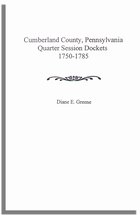
|
|
|
| Product Information: | ||
| Details: | Cumberland County, Pennsylvania Quarter Session Dockets 1750-1785; by Diane E. Greene, A.G.; vi + 346 pp; Paperback; Published: 2000; Reprinted: 2004; ISBN: 9780806349657; Item # CF9357D Cumberland County, Pennsylvania was formed from Lancaster County in 1750. It was itself the parent county, in whole or in part, of Bedford, Franklin, Perry, and Mifflin counties, all of which are situated in south central Pennsylvania. Using a typescript collection of extracts prepared by John G. Orr in 1925 and a microfilm copy of the original records photographed by the LDS Church, Ms. Greene has compiled a complete collection of abstracts of the Cumberland County Court Quarter Session Dockets for the period 1750-1785. With the exception of the period 1771-1785 for Bedford County, the Quarter Session records extracted by Ms. Greene apply to the original boundaries of Cumberland County .The Quarter Session Dockets themselves are something of a genealogical miscellany. During the 1750s, when the county seat was at Shippensburg, for example, a number of the entries pertained to criminal cases dealing with assault and battery, larceny, neglect of highway duty, and so on. Other matters before the court included appointments to the grand jury, defaults on payments, selling spirits without a license, and horse theft. When it came to abstracts from the 1770s, by which time the court sessions were being held in Carlisle, the dockets mostly listed the names of county officials, such as constables and overseers of roads, members of grand juries, and persons who had petitioned the court to lay out new roadways. Despite the paucity of records demonstrating family relationships, the Quarter Session Dockets have the great virtue of placing individuals in Cumberland County at a particular point in time during the second half of the 18th century. In fact, if the sought-after ancestor shows up in the 10,000-name index at the back of the book, the researcher may just have found the elusive clue needed for conducting further research in the records of Cumberland County. |
|

